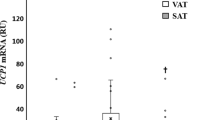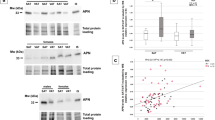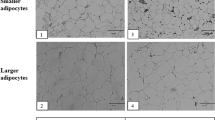Abstract
Objective:
Hypoadiponectinemia observed in obesity is associated with insulin resistance, diabetes and atherosclerosis. The aim of the present study was to investigate secretion of adiponectin and its multimeric isoforms by explants derived from subcutaneous adipose tissue (SAT) and visceral adipose tissue (VAT) in obese and non-obese subjects.
Design:
Paired samples of SAT and VAT and blood samples were obtained from 23 subjects (10 non-obese and 13 obese) undergoing elective abdominal surgery. Total adiponectin quantities and adiponectin isoforms were measured in conditioned media of explants derived from SAT and VAT using enzyme-linked immunosorbent assay and non-denaturing western blot, respectively.
Results:
Total adiponectin plasma levels were lower in obese than in non-obese subjects (P<0.05). Secretion of total adiponectin in adipose tissue (AT) explants was lower in obese than in non-obese subjects in SAT (P<0.05) but not in VAT. In both, SAT and VAT, the most abundant isoform released into conditioned media was the high-molecular weight (HMW) form. Its relative proportion in relation to total adiponectin was higher in conditioned media of explants from both fat depots when compared with plasma (P<0.001). The proportion of secreted HMW vs total adiponectin was higher in VAT than in SAT explants in the group of non-obese individuals (49.3±3.1% in VAT vs 40.6±2.8% in SAT; P<0.01), whereas no difference between the two depots was found in obese subjects (46.2±3.0 % in VAT vs 46.0±2.4 % in SAT).
Conclusion:
Obesity is associated with the decrease of total adiponectin secretion in SAT. The profile of adiponectin isoforms secreted by SAT and VAT explants differs from that in plasma. Secretion of total adiponectin and HMW isoform of adiponectin are different in obese and non-obese subjects in relation to AT depot.
This is a preview of subscription content, access via your institution
Access options
Subscribe to this journal
Receive 12 print issues and online access
$259.00 per year
only $21.58 per issue
Buy this article
- Purchase on Springer Link
- Instant access to full article PDF
Prices may be subject to local taxes which are calculated during checkout




Similar content being viewed by others
References
Despres JP, Lemieux I, Prud’homme D . Treatment of obesity: need to focus on high risk abdominally obese patients. BMJ 2001; 322: 716–720.
Wajchenberg BL . Subcutaneous and visceral adipose tissue: their relation to the metabolic syndrome. Endocr Rev 2000; 21: 697–738.
Perrini S, Laviola L, Cignarelli A, Melchiorre M, De Stefano F, Caccioppoli C et al. Fat depot-related differences in gene expression, adiponectin secretion, and insulin action and signalling in human adipocytes differentiated in vitro from precursor stromal cells. Diabetologia 2008; 51: 155–164.
Liu A, McLaughlin T, Liu T, Sherman A, Yee G, Abbasi F et al. Differential intra-abdominal adipose tissue profiling in obese, insulin-resistant women. Obes Surg 2009; 19: 1564–1573.
Ibrahim MM . Subcutaneous and visceral adipose tissue: structural and functional differences. Obes Rev 2009; 11: 11–18.
Arita Y, Kihara S, Ouchi N, Takahashi M, Maeda K, Miyagawa J et al. Paradoxical decrease of an adipose-specific protein, adiponectin, in obesity. Biochem Biophys Res Commun 1999; 257: 79–83.
Hotta K, Funahashi T, Arita Y, Takahashi M, Matsuda M, Okamoto Y et al. Plasma concentrations of a novel, adipose-specific protein, adiponectin, in type 2 diabetic patients. Arterioscler Thromb Vasc Biol 2000; 20: 1595–1599.
Kumada M, Kihara S, Sumitsuji S, Kawamoto T, Matsumoto S, Ouchi N et al. Association of hypoadiponectinemia with coronary artery disease in men. Arterioscler Thromb Vasc Biol 2003; 23: 85–89.
Montague CT, O’Rahilly S . The perils of portliness: causes and consequences of visceral adiposity. Diabetes 2000; 49: 883–888.
Bajzova M, Kovacikova M, Vitkova M, Klimcakova E, Polak J, Kovacova Z et al. Retinol-binding protein 4 expression in visceral and subcutaneous fat in human obesity. Physiol Res 2008; 57: 927–934.
Motoshima H, Wu X, Sinha MK, Hardy VE, Rosato EL, Barbot DJ et al. Differential regulation of adiponectin secretion from cultured human omental and subcutaneous adipocytes: effects of insulin and rosiglitazone. J Clin Endocrinol Metab 2002; 87: 5662–5667.
Drolet R, Belanger C, Fortier M, Huot C, Mailloux J, Legare D et al. Fat depot-specific impact of visceral obesity on adipocyte adiponectin release in women. Obesity (Silver Spring) 2009; 17: 424–430.
Hernandez-Morante JJ, Milagro FI, Lujan JA, Martinez JA, Zamora S, Garaulet M . Insulin effect on adipose tissue (AT) adiponectin expression is regulated by the insulin resistance status of the patients. Clin Endocrinol (Oxf) 2008; 69: 412–417.
Phillips SA, Kung J, Ciaraldi TP, Choe C, Christiansen L, Mudaliar S et al. Selective regulation of cellular and secreted multimeric adiponectin by antidiabetic therapies in humans. Am J Physiol Endocrinol Metab 2009; 297: E767–E773.
Wang Y, Lam KS, Yau MH, Xu A . Post-translational modifications of adiponectin: mechanisms and functional implications. Biochem J 2008; 409: 623–633.
Bouskila M, Pajvani UB, Scherer PE . Adiponectin: a relevant player in PPARgamma-agonist-mediated improvements in hepatic insulin sensitivity? Int J Obes (Lond) 2005; 29 (Suppl 1): S17–S23.
Waki H, Yamauchi T, Kamon J, Ito Y, Uchida S, Kita S et al. Impaired multimerization of human adiponectin mutants associated with diabetes. Molecular structure and multimer formation of adiponectin. J Biol Chem 2003; 278: 40352–40363.
Pajvani UB, Hawkins M, Combs TP, Rajala MW, Doebber T, Berger JP et al. Complex distribution, not absolute amount of adiponectin, correlates with thiazolidinedione-mediated improvement in insulin sensitivity. J Biol Chem 2004; 279: 12152–12162.
Fisher FF, Trujillo ME, Hanif W, Barnett AH, McTernan PG, Scherer PE et al. Serum high molecular weight complex of adiponectin correlates better with glucose tolerance than total serum adiponectin in Indo-Asian males. Diabetologia 2005; 48: 1084–1087.
Seino Y, Hirose H, Saito I, Itoh H . High molecular weight multimer form of adiponectin as a useful marker to evaluate insulin resistance and metabolic syndrome in Japanese men. Metabolism 2007; 56: 1493–1499.
Hajri T, Tao H, Wattacheril J, Marks-Shulman P, Abumrad NN . Regulation of adiponectin production by insulin: interactions with tumor necrosis factor-alpha and interleukin-6. Am J Physiol Endocrinol Metab 2011; 300: E350–E360.
Kaser S, Tatarczyk T, Stadlmayr A, Ciardi C, Ress C, Tschoner A et al. Effect of obesity and insulin sensitivity on adiponectin isoform distribution. Eur J Clin Invest 2008; 38: 827–834.
Kershaw EE, Flier JS . Adipose tissue as an endocrine organ. J Clin Endocrinol Metab 2004; 89: 2548–2556.
Arvidsson E, Viguerie N, Andersson I, Verdich C, Langin D, Arner P . Effects of different hypocaloric diets on protein secretion from adipose tissue of obese women. Diabetes 2004; 53: 1966–1971.
Hoffstedt J, Arvidsson E, Sjolin E, Wahlen K, Arner P . Adipose tissue adiponectin production and adiponectin serum concentration in human obesity and insulin resistance. J Clin Endocrinol Metab 2004; 89: 1391–1396.
Kovacova Z, Vitkova M, Kovacikova M, Klimcakova E, Bajzova M, Hnevkovska Z et al. Secretion of adiponectin multimeric complexes from adipose tissue explants is not modified by very low calorie diet. Eur J Endocrinol 2009; 160: 585–592.
Polak J, Kovacova Z, Jacek M, Klimcakova E, Kovacikova M, Vitkova M et al. An increase in plasma adiponectin multimeric complexes follows hypocaloric diet-induced weight loss in obese and overweight pre-menopausal women. Clin Sci (Lond) 2007; 112: 557–565.
Murdolo G, Hammarstedt A, Schmelz M, Jansson PA, Smith U . Acute hyperinsulinemia differentially regulates interstitial and circulating adiponectin oligomeric pattern in lean and insulin-resistant, obese individuals. J Clin Endocrinol Metab 2009; 94: 4508–4516.
Phillips SA, Ciaraldi TP, Oh DK, Savu MK, Henry RR . Adiponectin secretion and response to pioglitazone is depot dependent in cultured human adipose tissue. Am J Physiol Endocrinol Metab 2008; 295: E842–E850.
Bobbert T, Rochlitz H, Wegewitz U, Akpulat S, Mai K, Weickert MO et al. Changes of adiponectin oligomer composition by moderate weight reduction. Diabetes 2005; 54: 2712–2719.
Tabara Y, Osawa H, Kawamoto R, Tachibana-Iimori R, Yamamoto M, Nakura J et al. Reduced high-molecular-weight adiponectin and elevated high-sensitivity C-reactive protein are synergistic risk factors for metabolic syndrome in a large-scale middle-aged to elderly population: the Shimanami Health Promoting Program Study. J Clin Endocrinol Metab 2008; 93: 715–722.
Hirose H, Yamamoto Y, Seino-Yoshihara Y, Kawabe H, Saito I . Serum high-molecular-weight adiponectin as a marker for the evaluation and care of subjects with metabolic syndrome and related disorders. J Atheroscler Thromb 2010; 17: 1201–1211.
Bodles AM, Banga A, Rasouli N, Ono F, Kern PA, Owens RJ . Pioglitazone increases secretion of high-molecular-weight adiponectin from adipocytes. Am J Physiol Endocrinol Metab 2006; 291: E1100–E1105.
Kusminski CM, McTernan PG, Schraw T, Kos K, O’Hare JP, Ahima R et al. Adiponectin complexes in human cerebrospinal fluid: distinct complex distribution from serum. Diabetologia 2007; 50: 634–642.
Pajvani UB, Du X, Combs TP, Berg AH, Rajala MW, Schulthess T et al. Structure-function studies of the adipocyte-secreted hormone Acrp30/adiponectin. Implications fpr metabolic regulation and bioactivity. J Biol Chem 2003; 278: 9073–9085.
Schraw T, Wang ZV, Halberg N, Hawkins M, Scherer PE . Plasma adiponectin complexes have distinct biochemical characteristics. Endocrinology 2008; 149: 2270–2282.
Halberg N, Schraw TD, Wang ZV, Kim JY, Yi J, Hamilton MP et al. Systemic fate of the adipocyte-derived factor adiponectin. Diabetes 2009; 58: 1961–1970.
Bahceci M, Gokalp D, Bahceci S, Tuzcu A, Atmaca S, Arikan S . The correlation between adiposity and adiponectin, tumor necrosis factor alpha, interleukin-6 and high sensitivity C-reactive protein levels. Is adipocyte size associated with inflammation in adults? J Endocrinol Invest 2007; 30: 210–214.
Bambace C, Telesca M, Zoico E, Sepe A, Olioso D, Rossi A et al. Adiponectin gene expression and adipocyte diameter: a comparison between epicardial and subcutaneous adipose tissue in men. Cardiovasc Pathol 2011; 20: e153–e156.
Pasarica M, Tchoukalova YD, Heilbronn LK, Fang X, Albu JB, Kelley DE et al. Differential effect of weight loss on adipocyte size subfractions in patients with type 2 diabetes. Obesity (Silver Spring) 2009; 17: 1976–1978.
Skurk T, Alberti-Huber C, Herder C, Hauner H . Relationship between adipocyte size and adipokine expression and secretion. J Clin Endocrinol Metab 2007; 92: 1023–1033.
Cao YL, Hu CZ, Meng X, Wang DF, Zhang J . Expression of TNF-alpha protein in omental and subcutaneous adipose tissue in obesity. Diabetes Res Clin Pract 2008; 79: 214–219.
Zha JM, Di WJ, Zhu T, Xie Y, Yu J, Liu J et al. Comparison of gene transcription between subcutaneous and visceral adipose tissue in Chinese adults. Endocr J 2009; 56: 935–944.
Maeda N, Takahashi M, Funahashi T, Kihara S, Nishizawa H, Kishida K et al. PPARgamma ligands increase expression and plasma concentrations of adiponectin, an adipose-derived protein. Diabetes 2001; 50: 2094–2099.
Lo J, Bernstein LE, Canavan B, Torriani M, Jackson MB, Ahima RS et al. Effects of TNF-alpha neutralization on adipocytokines and skeletal muscle adiposity in the metabolic syndrome. Am J Physiol Endocrinol Metab 2007; 293: E102–E109.
Stanley TL, Zanni MV, Johnsen S, Rasheed S, Makimura H, Lee H et al. TNF-alpha antagonism with etanercept decreases glucose and increases the proportion of high molecular weight adiponectin in obese subjects with features of the metabolic syndrome. J Clin Endocrinol Metab 2011; 96: E146–E150.
Acknowledgements
The study was supported by GAUK1269/08/C/2008; Integrated Project HEPADIP (http://www.hepadip.org), Contract No. LSH-2003-1.1.3-1, and Collaborative Project ADAPT (http://www.adapt-eu.net), Contract No. HEALTH-F2-2008-2011 00). The Research Project of the Czech Ministry of Education MSM 0021620814. We would like to thank to Karin Doležalová, MD, Anna Jungwirthová, MD and David Melechovskỳ, MD, for the collection of adipose tissue samples and cooperation on the study.
Author information
Authors and Affiliations
Corresponding author
Ethics declarations
Competing interests
The authors declare no conflict of interest.
Rights and permissions
About this article
Cite this article
Kovacova, Z., Tencerova, M., Roussel, B. et al. The impact of obesity on secretion of adiponectin multimeric isoforms differs in visceral and subcutaneous adipose tissue. Int J Obes 36, 1360–1365 (2012). https://doi.org/10.1038/ijo.2011.223
Received:
Revised:
Accepted:
Published:
Issue Date:
DOI: https://doi.org/10.1038/ijo.2011.223
Keywords
This article is cited by
-
Abdominal subcutaneous adipose tissue: a favorable adipose depot for diabetes?
Cardiovascular Diabetology (2018)
-
Obesity-related insulin resistance: implications for the surgical patient
International Journal of Obesity (2015)
-
IGFBP-2 inhibits adipogenesis and lipogenesis in human visceral, but not subcutaneous, adipocytes
International Journal of Obesity (2015)
-
Adiponectin, chemerin, cytokines, and dipeptidyl peptidase 4 are released from human adipose tissue in a depot-dependent manner: an in vitro system including human serum albumin
BMC Endocrine Disorders (2014)
-
Inherent insulin sensitivity is a major determinant of multimeric adiponectin responsiveness to short-term weight loss in extreme obesity
Scientific Reports (2014)



